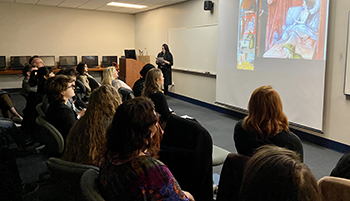Ancient Egyptian “Condemnation of Memory,” Iconoclasm or Damnatio memoriae
Description/Abstract/Artist Statement
This paper focuses on the reasons and contemporary consequences of ancient Egyptian “condemnation of memory,” better known as iconoclasm and, in some cases, damnatio memoriae. Most scholarship focuses on ancient Egyptian iconoclasm as an act of political or social erasure. For example, Tuthmosis III’s attempted erasure of Hatshepsut, as a way to make it seem as though he never had a regent and as trying to take credit for all of her accomplishments. The ancient Egyptians were a highly religious people, with religion woven into every aspect of their lives. It is an oversight not to remember such religiosity when examining their iconoclastic habits. This paper argues that iconoclasm, when seen in Egyptian contexts, was a spiritual act. The primary goal of Egyptian iconoclasts was suffering in, or removal from, the afterlife. All other politico-historical benefits came second. By examining the acts of iconoclasm following the reign of Akhenaten and the Amarna period and the epigraphy from the mortuary complex of Hatshepsut and the erasure of the female King’s name we find that iconoclasts targeted names and faces, as though ritually attacking their personal identity as an effort to deprive them of eternity.
Faculty Advisor/Mentor
Jared Benton
Presentation Type
Oral Presentation
Disciplines
Other History of Art, Architecture, and Archaeology
Session Title
College of Arts & Letters 3
Location
Learning Commons @ Perry Library Room 1306
Start Date
2-8-2020 10:15 AM
End Date
2-8-2020 11:00 AM
Ancient Egyptian “Condemnation of Memory,” Iconoclasm or Damnatio memoriae
Learning Commons @ Perry Library Room 1306
This paper focuses on the reasons and contemporary consequences of ancient Egyptian “condemnation of memory,” better known as iconoclasm and, in some cases, damnatio memoriae. Most scholarship focuses on ancient Egyptian iconoclasm as an act of political or social erasure. For example, Tuthmosis III’s attempted erasure of Hatshepsut, as a way to make it seem as though he never had a regent and as trying to take credit for all of her accomplishments. The ancient Egyptians were a highly religious people, with religion woven into every aspect of their lives. It is an oversight not to remember such religiosity when examining their iconoclastic habits. This paper argues that iconoclasm, when seen in Egyptian contexts, was a spiritual act. The primary goal of Egyptian iconoclasts was suffering in, or removal from, the afterlife. All other politico-historical benefits came second. By examining the acts of iconoclasm following the reign of Akhenaten and the Amarna period and the epigraphy from the mortuary complex of Hatshepsut and the erasure of the female King’s name we find that iconoclasts targeted names and faces, as though ritually attacking their personal identity as an effort to deprive them of eternity.


